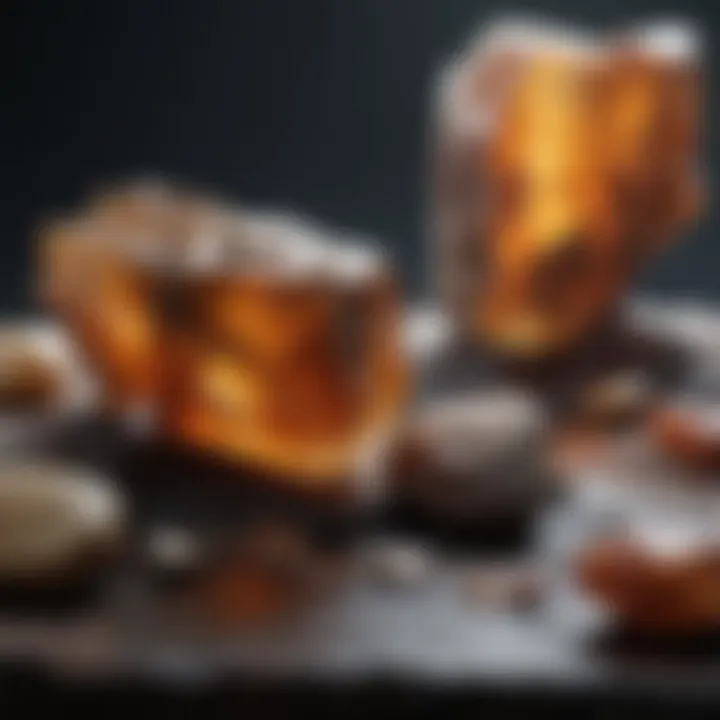Understanding Lapidary Mineral Oil: Uses and Benefits


Intro
Lapidary mineral oil is an oft-overlooked component within the realm of stone polishing and mineral preservation. Its unique properties enhance the beauty of gemstones and mineral specimens, making it essential for enthusiasts and collectors alike. By understanding how mineral oil interacts with various minerals, one can achieve superior results in both restoration and maintenance.
Many collectors may not realize the significant role that lapidary mineral oil plays in extending the lifespan and appearance of their prized specimens. This article seeks to elucidate the myriad properties and applications of mineral oil while providing insights into best practices and alternatives.
Featured Collectible of the Month
Overview
For this month's featured collectible, we turn our focus to the dazzling world of fluorite. Known for its vibrant colors and unique fluorescence, this mineral exemplifies the properties of lapidary mineral oil when applied correctly. When polished with mineral oil, fluorite not only shows its inherent beauty but also reflects the skill and dedication of the lapidary artist.
Historical Significance
Fluorite has a storied history, used by various cultures for its beauty and perceived healing properties. Ancient Chinese artisans utilized this mineral in carvings and sculptures, which highlighted its aesthetic value. Today, lapidary mineral oil plays an integral role in maintaining these historical pieces, ensuring that they remain visually striking for generations to come.
Properties of Lapidary Mineral Oil
Lapidary mineral oil is characterized by its light viscosity and low volatility. It is chemically inert, meaning it does not react with most minerals, protecting them during the polishing process. This oil also has excellent lubricating properties, preventing scratches and enhancing the shine of the stones.
Key properties of lapidary mineral oil:
- Light viscosity: Allows for easy application.
- Chemical inertness: Suitable for a wide range of minerals.
- Lubricating qualities: Prevents damage during polishing.
- Enhancing shine: Provides a lasting luster to polished stones.
Applications in Lapidary Work
Lapidary mineral oil serves multiple functions in stone polishing. It is primarily used to enhance the feel and appearance of the stone during the grinding and polishing process. Furthermore, its protective qualities prolong the life of the mineral, preventing damage from environmental factors.
Using mineral oil in lapidary work is beneficial in the following ways:
- Polishing: It creates a smooth surface on the stone, enhancing its natural colors.
- Preservation: It protects against moisture and dust.
- Stabilization: It can help solidify loose particles on softer minerals.
Identification Techniques
Visual Characteristics
To identify lapidary mineral oil, examine its clarity and viscosity. The oil should be clear, without any cloudiness. When spread on a mineral, it should easily coat the surface, allowing the stone to absorb it without excessive pooling.
Resources for Identification
Several online platforms can provide additional insights into identifying lapidary mineral oil and its properties. Key resources include:
The insights in this article aim to provide a deeper understanding of lapidary mineral oil and its essential role in the world of geology and mineralogy. With the right knowledge, collectors can not only enjoy but also effectively care for their valuable stones.
Foreword to Lapidary Mineral Oil
Lapidary mineral oil is more than just a fluid used in stone polishing; it is a vital component that ensures both the aesthetic and structural integrity of mineral specimens. Its role extends to various applications in lapidary work, providing benefits that enhance the quality of the finished product. Understanding lapidary mineral oil can profoundly impact how collectors and artisans approach their craft. This section highlights the foundational aspects that make lapidary mineral oil a significant subject for exploration, focusing on its characteristics, uses, and the considerations that come with its application.
What is Lapidary Mineral Oil?
Lapidary mineral oil is a refined petroleum product that serves as a lubricant and protector for stones and minerals during the polishing process. It is preferable for many lapidary techniques due to its specific properties. This oil has low viscosity, which allows for smooth application, helping to reduce friction and heat buildup on the stone's surface. It also acts as a medium to carry abrasives more effectively when polishing.
The clarity of lapidary mineral oil means it does not interfere with the natural appearance of the stones, making it suitable for various types of minerals, including soft and hard stones. Its molecular composition ensures that it does not cause any adverse reactions with the minerals, which is an essential factor for lapidary artists and collectors alike.
Historical Context
The use of oils in stone polishing can be traced back to ancient civilizations. Early lapidists recognized that certain oils could enhance the polishing process. Traditional techniques often involved the use of natural oils, which, while effective, had limitations in purity and consistency. As industrialization progressed, the production of lapidary mineral oil began, providing a more reliable and efficient option.
In the modern era, lapidary mineral oil has become a standard in the field. It is widely adopted because it offers enhanced performance over its natural counterparts. The importance of this development cannot be understated, especially for collectors who strive for perfection in their mineral specimens.


Understanding the historical evolution of lapidary mineral oil helps frame its current significance in lapidary practices. Its ongoing importance in the preservation and care of minerals reflects the dynamic interplay between traditional methods and contemporary technology.
Chemical Composition
Understanding the chemical composition of lapidary mineral oil is crucial to grasping its function and efficacy in the world of stone polishing and mineral care. The composition not only determines the performance of the oil but also its interaction with different mineral types. This section will explore the primary ingredients, purity levels, and the distillation processes that play a significant role in defining the quality and characteristics of lapidary mineral oil.
Primary Ingredients
Lapidary mineral oil primarily consists of saturated hydrocarbons. These compounds are often derived from petroleum through processes that refine crude oil into a usable form. The main constituents include:
- Alkanes: These are linear and branched chain hydrocarbons known for their stability and low reactivity. Their presence contributes significantly to the oil's viscosity and lubrication properties.
- Cycloalkanes: Also known as naphthenes, these ring-structured hydrocarbons help in enhancing the oil's fluidity.
- Aromatics: While typically undesirable in high concentrations due to potential impurities, small amounts can influence the oil's fragrance and certain physical properties.
The high percentage of saturated compounds makes lapidary mineral oil an effective choice for polishing as they evaporate slowly and minimize the chance of damage to the stones. Hence, users should look for products with a higher concentration of these saturated hydrocarbons for optimal performance.
Purity and Distillation Processes
Purity is a vital aspect when selecting lapidary mineral oil. Impurities can lead to various issues, including instability and a higher likelihood of degradation. The distillation process is fundamental in achieving a high-purity product.
- Fractional Distillation: This method is essential to separate and concentrate the desired hydrocarbons while discarding unwanted fractions. During this process, crude oil is heated, and the vapors are collected at different temperatures to yield high-purity mineral oil.
- Deodorization and Filtration: Additional processes may include deodorization to remove any lingering odors, along with fine filtration to eliminate any residual particulate matter.
Achieving a high level of purity minimizes the potential for any adverse reactions with various minerals, making lapidary mineral oil a reliable choice for collectors and lapidary artists who seek to maintain the integrity of their specimens.
"The quality of lapidary mineral oil can significantly affect not just the polishing process but also the preservation of minerals themselves."
In summary, the chemical composition of lapidary mineral oil is integral to its effectiveness as a polishing agent and protective medium for stones. Its primary ingredients and the processes used to ensure purity play a pivotal role in the outcomes achieved by collectors and those engaged in mineral care.
Properties of Lapidary Mineral Oil
The properties of lapidary mineral oil are critical in understanding its effectiveness and application in lapidary work. These characteristics dictate how the oil interacts with different minerals, influencing the overall outcome during polishing and maintenance.
Viscosity and Fluid Dynamics
Viscosity is a key property of lapidary mineral oil, determining how thick or thin the oil is. The viscosity directly affects fluid dynamics during the polishing process. A higher viscosity means the oil is thicker, providing better lubrication but may not spread easily over the surface of the stone. Conversely, a lower viscosity allows for easier application but may not provide sufficient protection or lubrication.
For lapidary artisans, choosing the proper viscosity is crucial. If the oil is too viscous, it may hinder the polishing process and lead to uneven finishes. This is particularly important when working with delicate or intricate stone designs. Therefore, the selection of lapidary mineral oils with specific viscosity ratings can optimize the results of polishing operations.
Effect of Temperature
Temperature plays a significant role in the performance of lapidary mineral oil. As temperatures increase, the viscosity of the oil decreases, making it more fluid. This can alter how the oil behaves during polishing, potentially leading to faster application and more even coverage. However, at high temperatures, the oil can evaporate more quickly, diminishing its effectiveness and requiring more frequent reapplication.
Artisans should be aware of the working environment and adjust their use of lapidary mineral oil accordingly. For example, in cooler conditions, thicker oils may be more effective at retaining their properties. In contrast, during warmer months, choosing a lighter oil might enhance the polishing experience. Understanding these temperature interactions helps in making informed decisions, optimizing the effectiveness of lapidary mineral oil in various work settings.
The right viscosity and temperature control are crucial for achieving optimal results in lapidary work.
In summary, the properties of lapidary mineral oil, particularly viscosity and temperature effects, are essential for ensuring the best outcomes in polishing and preserving minerals. A careful consideration of these elements can enhance not only the aesthetic quality of stones but also their longevity, making these insights valuable for collectors and artisans alike.
Applications in Lapidary Work
Lapidary mineral oil serves as a foundational element in the realm of stone polishing and mineral care. Its properties make it suitable for various applications that enhance both the aesthetic appeal and longevity of mineral specimens. Understanding these applications allows collectors and enthusiasts to maximize their efforts in preserving and showcasing their collection.
Stone Polishing Techniques
Polishing stones with mineral oil involves several techniques, aimed at achieving the desired finish while protecting the stone's integrity. The oil acts as a lubricant during the polishing process, reducing friction and preventing heat damage to the minerals.
Key techniques include:
- Wet Polishing: This method involves applying lapidary mineral oil directly to the surface while using polishing pads or cloths. The oil allows for smoother abrasion with grit compounds, yielding a high-gloss finish.
- Buffing: Using a buffing wheel combined with mineral oil can provide additional shine. The oil helps to keep the surface cool and prevents dust from settling on the surface, ensuring an even polish.
- Hand Polishing: In cases where precision is necessary, hand application of the oil during polishing ensures control over the polishing process. It allows for attention to detail, especially on intricate designs.
Ultimately, these techniques lead to a polished stone that is not only visually appealing but also displays better clarity and depth.
Preventative Care for Minerals


In addition to polishing, lapidary mineral oil plays a significant role in preventative care for minerals. When properly applied, it helps to shield stones from environmental factors that may cause damage.
Consider the following advantages of using mineral oil in preventative care:
- Moisture Barrier: Mineral oil creates a protective layer against moisture, which can be detrimental to certain minerals. This barrier prevents water from seeping into porous stones, reducing the risk of cracking or fading.
- Dirt and Dust Repellent: Applying mineral oil can help prevent the accumulation of dirt and grime on the surface of stones. This is particularly useful for display pieces that may gather dust over time.
- Longevity of Polish: Regular maintenance with mineral oil can extend the life of polished surfaces. By reapplying oil periodically, collectors can maintain the shine and luster of their minerals.
"Regular application of lapidary mineral oil not only enhances but also protects precious stones, ensuring they remain in optimal condition for years to come."
Advantages of Using Lapidary Mineral Oil
Lapidary mineral oil is a significant substance in the domain of stone polishing and mineral care. Its advantages are numerous and range from enhancing the aesthetic appeal of the stones to providing important protective qualities. Collectors and enthusiasts alike can benefit greatly from understanding these essential advantages thoroughly.
Enhancing Surface Gloss
One of the primary benefits of lapidary mineral oil is its ability to enhance the surface gloss of various stones. When applied properly, the oil provides a glossy finish that can substantially increase the visual appeal of polished stones. The optical properties of the mineral oil improve the refractive index of the stones, making them appear brighter and more vibrant.
Furthermore, this glossy layer acts to smooth out minor imperfections in the stone surface. A polished surface that reflects light well attracts attention, which is invaluable for collectors wanting to showcase their specimens.
Providing Protection Against Moisture
Lapidary mineral oil serves as a barrier against moisture. Moisture can lead to damage in various ways, including promoting oxidation or rust on metallic inclusions in softer stones. By applying a layer of mineral oil, one effectively seals the surface, preventing moisture ingress. This property is crucial for collectors who wish to maintain the integrity and appearance of their specimens over time.
Beyond protecting against moisture, this oil also minimizes the chances of dirt and grime adhering to the stone. This, in turn, reduces the frequency of necessary cleanings, allowing for longer preservation of the stone’s condition.
Ease of Application
Using lapidary mineral oil is straightforward, making it an accessible option for collectors of all skill levels. Generally, it requires clean stones and a simple application process. A soft cloth can be used to evenly spread the oil across the surface.
Moreover, the oil's consistency allows for easy control during application, helping to ensure an even coat without excessive buildup. This aspect of mineral oil not only simplifies the polishing process but also ensures that users achieve the desired outcomes consistently.
"The use of lapidary mineral oil represents a smart choice for those seeking both aesthetic and protective benefits in mineral care."
In summary, the advantages of using lapidary mineral oil are manifold. Its ability to enhance surface gloss, provide moisture protection, and facilitate easy application makes it an invaluable addition to the toolkit of any serious collector or enthusiast. These factors contribute significantly to the overall preservation and presentation of mineral specimens, creating lasting value for collectors.
Cautions and Considerations
In the realm of lapidary work, the use of mineral oil is not without its considerations. Proper understanding of the potential risks and best practices is essential for both hobbyists and professionals. This section will scrutinize important elements regarding mineral oil, focusing specifically on appropriate selection and its effects on various minerals. The objective is to provide a thorough understanding that aids in making informed decisions.
Choosing the Right Type of Mineral Oil
Selecting the suitable mineral oil is of great significance. Not all mineral oils are created equally, as their formulations can vary based on purity and intended purpose. Generally, mineral oils can be categorized as either light or heavy, each having unique characteristics and uses.
Light mineral oils are more translucent and tend to be less viscous. These are commonly used for polishing softer stones where a thin layer and less residue are preferred. Heavy mineral oils, on the other hand, provide better lubrication and are often recommended for tougher materials that require more protection during polishing.
When choosing mineral oil, one must consider:
- Purity: Impurities can lead to unwanted chemical reactions with stones.
- Viscosity: This impacts how well the oil works for specific applications.
- Preservation of Color: Some oils might alter the appearance or color of certain stones.
Opt for a product that is specifically marketed for lapidary work, as this ensures compatibility with the materials being polished. Issue can arise if oils contain additives or fragrances that might be detrimental to certain minerals. Evaluating supplier recommendations can also guide proper selection.
Potential Effects on Different Minerals
Mineral oil's effect on stones varies considerably based on their composition. Some minerals may respond favorably, while others could be adversely impacted. Understanding these dynamics ensures effective and safe applications in lapidary practices.
Consider the following effects:
- Hydrocarbon Sensitivity: Some softer stones may absorb the oil leading to changes in texture or appearance.
- Color Change: Dark stones may become more vibrant, while lighter stones can take on an oily sheen, sometimes leading to undesired effects.
- Long-term Preservation: Over time, oils can cause discolouration or degradation of some minerals if not properly cleaned off post-application.
To mitigate negative outcomes, it is advisable to test any new oil on a small, inconspicuous area of the stone. This helps to gauge potential reactions without compromising the entire specimen.
Best Practices for Application


Applying lapidary mineral oil requires careful attention to detail to achieve the best results. Understanding the nuances of proper application not only enhances the outcome but also preserves the integrity of the stones being polished or protected. Following best practices ensures that collectors get maximum benefits from mineral oil, while minimizing any potential damage to their collection.
Preparation of Stones
Before applying lapidary mineral oil, it is essential to prepare the stones adequately. Preparation involves cleaning the stones thoroughly to remove any dust, dirt, or pre-existing oils that may interfere with the application process.
- Cleaning: Use a soft brush or cloth dampened with water to gently scrub the stone's surface. This helps to remove embedded particles without scratching or damaging the finish.
- Drying: After cleaning, allow the stones to dry completely. This is crucial because applying mineral oil to wet surfaces can cause uneven absorption and may even lead to staining.
- Inspection: Examine the stones for cracks or chips. Repair any significant damage before applying mineral oil, as the oil will enhance visibility of imperfections rather than hide them.
Techniques for Application
Once the stones are prepared, the next step involves the techniques for applying lapidary mineral oil. The method of application influences how effectively the oil adheres and protects the stone.
- Using a Soft Cloth: Dampen a lint-free cloth with a small amount of lapidary mineral oil. It is important not to soak the cloth; a light application is more effective.
- Even Application: Gently but firmly rub the cloth over the stone in circular motions, ensuring even coverage. This technique promotes better absorption into the stone's surface.
- Let it Soak: After applying, allow the mineral oil to sit on the surface for a few minutes. This helps it penetrate. For porous stones, extending this time may be necessary for optimal results.
- Wiping Off Excess: Finally, use a clean section of the cloth to wipe away any excess oil. This step is vital to avoid leaving a greasy residue that can attract dust or diminish the stone's appearance.
Properly applying lapidary mineral oil can enhance the aesthetic quality of stones while protecting against moisture exposure.
In summary, applying lapidary mineral oil is a meticulous process that involves preparation and technique. By following these best practices, collectors can ensure their stones remain in prime condition for years to come.
Alternatives to Lapidary Mineral Oil
In the realm of lapidary work, while lapidary mineral oil holds a prominent position, its alternatives are also worth examining. Understanding these options is vital for stone polishing and mineral care. Each alternative brings different properties and benefits which can suit specific requirements or preferences in the lapidary community. Collectors and artisans alike should consider various factors before choosing the most appropriate products for their work.
Natural Oils
Natural oils have gained attention as alternative options to lapidary mineral oil. These oils include options like olive oil, coconut oil, and jojoba oil. Each possess unique characteristics that can be beneficial in lapidary applications. For example, olive oil has moisturizing properties, which can enhance the surface of softer stones while providing a natural sheen.
Coconut oil is known for its ability to penetrate materials effectively due to its lower molecular weight. It can aid in the preservation of certain stones without causing any detrimental effects. Jojoba oil is particularly interesting due to its wax-like properties. This means it evaporates slowly, allowing for extended protection against moisture.
These natural oils are often preferred for their eco-friendliness. Here are some benefits and considerations of using natural oils:
- Benefits:
- Considerations:
- Eco-friendly and derived from renewable resources.
- Typically safe for both the user and the environment.
- Nutritional content can aid the preservation of specific minerals.
- They may not provide the same level of sheen or protection against moisture as mineral oil does.
- They can degrade over time, leading to potentially sticky residues.
Synthetic Options
Synthetic options are becoming increasingly popular in lapidary practices. Products such as synthetic polishing oils or compounds have been specially formulated to offer targeted features that sometimes surpass lapidary mineral oil. For instance, some synthetic options offer controlled viscosity and enhanced lubrication, which can aid in the polishing process.
Synthetic oils, like those based on polyethylene or other polymers, can provide excellent protection against moisture and other environmental factors. They also tend to have longer shelf lives and less chance of degradation over time compared to their natural counterparts.
When considering synthetic options, the following points emerge:
- Benefits:
- Considerations:
- Consistency in quality and performance throughout the application.
- Tailored formulations that can cater to specific mineral types.
- Longer lasting results without the fear of degradation.
- May not be biodegradable and can pose environmental concerns.
- Certain synthetic products can be more expensive than natural or mineral oils.
In summary, while lapidary mineral oil continues to be a staple in lapidary work, exploring both natural and synthetic alternatives can deliver a broader range of benefits tailored to individual needs and preferences. Making informed choices ensures that your gemstones receive the best possible care.
End
The conclusion serves as a vital component of any analytical discourse. In the case of lapidary mineral oil, it brings together various threads discussed throughout the article, reinforcing the relevance and importance of this substance in stone polishing and mineral care.
Summation of Key Points
Lapidary mineral oil is not merely a tool; it is an essential element in the meticulous process of enhancing stones and preserving their natural beauty. Some key points to remember include:
- Purpose: Lapidary mineral oil aids in polishing stones, ensuring a smooth finish and enhancing surface gloss.
- Protection: It acts as a barrier against moisture damage, which is crucial for maintaining the integrity of various minerals.
- Versatility: The oil is suitable for a wide range of minerals, making it a go-to choice for collectors.
- Application Techniques: Best practices in its application can greatly affect the final outcome, emphasizing preparation and method.
Future Trends in Lapidary Practices
As we look ahead, the field of lapidary work and the utilization of mineral oil are likely to evolve. Some emerging trends to consider include:
- Sustainable Practices: There is a growing interest in eco-friendly options, potentially leading to the development of natural and biodegradable alternatives to mineral oil.
- Technological Innovations: The introduction of improved application tools may enhance efficiency, making stone care easier and more effective.
- Increased Education: As more individuals take up lapidary work, educational resources and community engagement via platforms like Reddit may become more crucial in sharing knowledge and techniques.
In summary, understanding lapidary mineral oil not only offers insights into effective stone care but also reflects a broader trend in mineral preservation that rocks collectors must consider for future practices.



